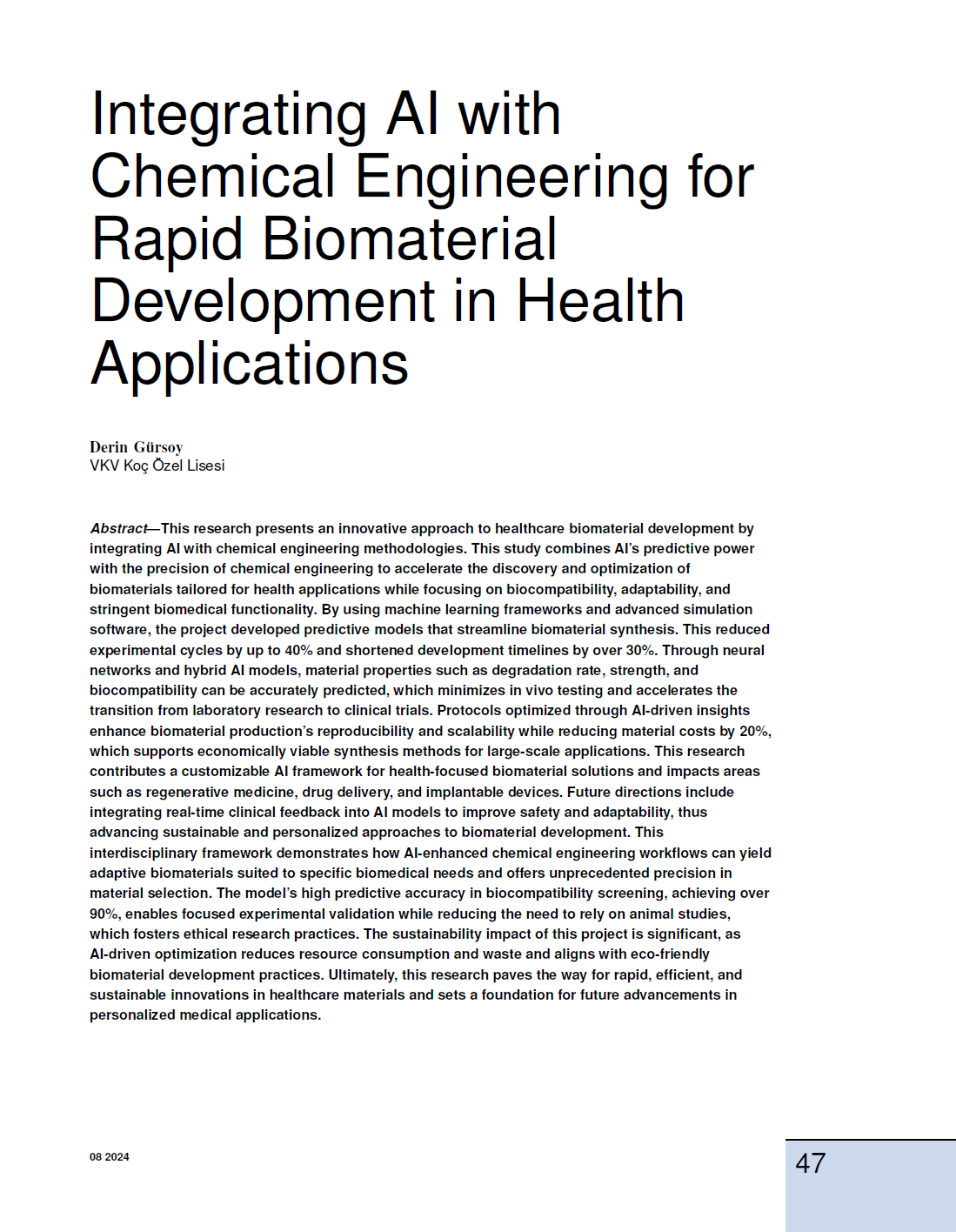Integrating AI with Chemical Engineering for Rapid Biomaterial Development in Health Applications
DOI:
https://doi.org/10.62802/ac0j8041Keywords:
healthcare biomaterials, AI, artificial intelligence, chemical engineering, biomaterial development, machine learning, personalized medicine, material synthesis, biocompatibilityAbstract
This research presents an innovative approach to healthcare biomaterial development by integrating AI with chemical engineering methodologies. This study combines AI’s predictive power with the precision of chemical engineering to accelerate the discovery and optimization of biomaterials tailored for health applications while focusing on biocompatibility, adaptability, and stringent biomedical functionality. By using machine learning frameworks and advanced simulation software, the project developed predictive models that streamline biomaterial synthesis. This reduced experimental cycles by up to 40% and shortened development timelines by over 30%. Through neural networks and hybrid AI models, material properties such as degradation rate, strength, and biocompatibility can be accurately predicted, which minimizes in vivo testing and accelerates the transition from laboratory research to clinical trials. Protocols optimized through AI-driven insights enhance biomaterial production’s reproducibility and scalability while reducing material costs by 20%, which supports economically viable synthesis methods for large-scale applications. This research contributes a customizable AI framework for health-focused biomaterial solutions and impacts areas such as regenerative medicine, drug delivery, and implantable devices. Future directions include integrating real-time clinical feedback into AI models to improve safety and adaptability, thus advancing sustainable and personalized approaches to biomaterial development. This interdisciplinary framework demonstrates how AI-enhanced chemical engineering workflows can yield adaptive biomaterials suited to specific biomedical needs and offers unprecedented precision in material selection. The model’s high predictive accuracy in biocompatibility screening, achieving over 90%, enables focused experimental validation while reducing the need to rely on animal studies, which fosters ethical research practices. The sustainability impact of this project is significant, as AI-driven optimization reduces resource consumption and waste and aligns with eco-friendly biomaterial development practices. Ultimately, this research paves the way for rapid, efficient, and sustainable innovations in healthcare materials and sets a foundation for future advancements in personalized medical applications.
References
Adhikari, S., Minevich, B., Redeker, D., Michelson, A. N., Emamy, H., Shen, E., ... & Kumar, S. K. (2023). Controlling the Self-Assembly of DNA Origami Octahedra via Manipulation of Inter-Vertex Interactions. Journal of the American Chemical Society, 145(36), 19578-19587.
Akca, A. H., Ma, S., Esposito, D., & Kawashima, S. (2022). Evaluation of mechanical performance of compacted magnesium hydroxide after carbonation curing. Journal of Materials in Civil Engineering, 34(5), 04022056.
Arnon, Z. A., Piperno, S., Redeker, D. C., Randall, E., Tkachenko, A. V., Shpaisman, H., & Gang, O. (2024). Acoustically shaped DNA-programmable materials. Nature Communications, 15(1), 6875.
Banta, S. (2023). How a protein differentiates between rare-earth elements.
Chen, C., Wu, Y., Wang, S. T., Berisha, N., Gang, O., & Heller, D. (2023). Fragment-based drug nanoaggregation reveals drivers of self-assembly. Biophysical Journal, 122(3), 550a.
Gokulu, I. S., & Banta, S. (2023). Biotechnology applications of proteins functionalized with DNA oligonucleotides. Trends in Biotechnology, 41(4), 575-585.
Mao, R., Minevich, B., McKeen, D., Chen, Q., Lu, F., Gang, O., & Mittal, J. (2023). Regulating phase behavior of nanoparticle assemblies through engineering of DNA-mediated isotropic interactions. Proceedings of the National Academy of Sciences, 120(52), e2302037120.
Shani, L., MIchelson, A., Redeker, D., Redeker, D., Lee, W., Kisslinger, K., ... & Gang, O. (2024). Selective Area Grown DNA origami Superlattice Assembly for Scalable Device Synthesis. Bulletin of the American Physical Society.
Su, Z., Renner, J., & Banta, S. (2023, November). Protein Engineering for Microbial Interface Study. In 2023 AIChE Annual Meeting. AIChE.
Wang, S. T., Gang, O., Zuckermann, R. N., & Bertozzi, C. R. (2023). U.S. Patent No. 11,739,162. Washington, DC: U.S. Patent and Trademark Office.









